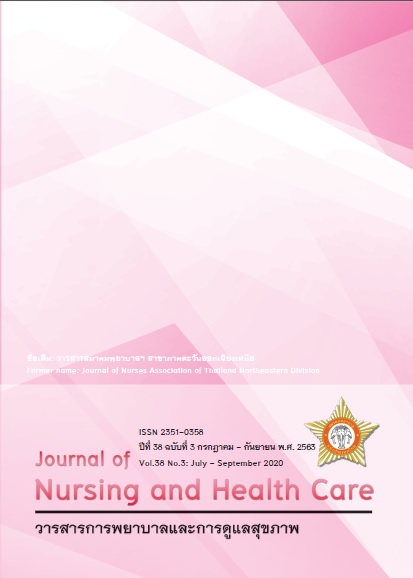สมรรถนะพยาบาลวิชาชีพไทยแลนด์ 4.0 โรงพยาบาลชุมชนระดับ F1-F3
คำสำคัญ:
สมรรถนะ พยาบาลวิชาชีพ ไทยแลนด์ 4.0 โรงพยาบาลชุมชนระดับ F1-F3บทคัดย่อ
การวิจัยเชิงพรรณนานี้มีวัตถุประสงค์เพื่อศึกษาสมรรถนะพยาบาลวิชาชีพไทยแลนด์ 4.0 โรงพยาบาลชุมชนระดับ F1-F3 โดยใช้เทคนิคเดฟาย ผู้เชี่ยวชาญเข้าร่วมในการลงความเห็นและให้ข้อมูล 23 คน เครื่องมือใช้แบบสอบถามสามชุดในการสำรวจสามรอบ ได้แก่ 1) แบบสอบถามปลายเปิดให้ผู้เชี่ยวชาญเขียนตอบในรอบแรก แล้วผู้วิจัยวิเคราะห์เนื้อหาและส่งกลับให้ผู้เชี่ยวชาญตรวจสอบได้ 11 สมรรถนะ 89 ข้อ 2) แบบสอบถามแบบ Likert scale 5 ระดับจากสมรรถนะ 89 ข้อ ส่งให้ผู้เชี่ยวชาญลงคะแนน เมื่อได้รับแบบสอบถามรอบที่ 2 นำไปคำนวณหาค่า MD และค่า IR และ 3) แบบสอบถามแบบ Likert scale 5 ระดับพร้อมค่า MD และ IR ทุกข้อคำถามพร้อมคำตอบผู้เชี่ยวชาญแต่ละท่าน ส่งให้ผู้เชี่ยวชาญลงคะแนนอีกครั้ง เมื่อได้รับแบบสอบถามรอบที่ 3 นำไปหาค่า MD และค่า IR อีกครั้ง เพื่อคัดเลือกสมรรถนะไทยแลนด์ 4.0 ที่มีค่ามัธยฐาน > 4 และมีค่าพิสัยระหว่างควอไทล์ < 1
ผลการศึกษาพบว่า ผู้เชี่ยวชาญได้ลงความเห็นให้สมรรถนะ 89 ข้อ อยู่ในระดับความสำคัญมากที่สุด MD=5 กับระดับมาก MD=4 มีความสอดคล้องกันทุกข้อค่า IR = 0 กับ 1 ดังนั้น สมรรถนะทั้ง 89 ข้อจึงเป็นสมรรถนะพยาบาลวิชาชีพไทยแลนด์ 4.0 โรงพยาบาลชุมชนะดับ F1-F3 สามารถนำไปพัฒนาเป็นเครื่องมือ และเป็นแนวทางในในการประเมินสมรรถนะพยาบาลวิชาชีพไทยแลนด์ 4.0 โรงพยาบาลชุมชนระดับ F1-F3
Downloads
เอกสารอ้างอิง
Model for Driving Thailand to Wealth,Stability and Sustainability. [database on Internet]. 2016
[cited 2019 Feb 18]. Available from: http://www.libarts.up.ac.th/v2/img/Thailand-4.0.pdf
2. Strategy and Planning Division Office of the Permanent Secretary Ministry of Public Health.
20-year national strategy for public health (2017-2036). (database on Internet).2018 (cited 2019
Feb 18). Available from:http://planning2.mju.ac.th/goverment/20111119104835 planning/Doc
25591128110914 828816.pdf
3. Bawornthip P.and P. Krithira. Community Nurse Roles in Using Health Care Technology for
Patients with Hypertension in Thailand 4.0 Journal of Nursing Association of Thailand,
Northern Branch 2018; 25(1): 14-22.
4. P. Wansa. Thailand Health 4.0 challenges and opportunities Journal of the Thai Medical Informatic Association 2017; 1:31-36.
5. McClelland DC. Testing for competence rather than intelligence. American Psychologist 1973;28(1):1-14.
6. Chansawat C. Factors of Professional Nursing Competency, Southern Community Hospital. Master of Nursing Science Thesis Nursing Administration Program, Faculty of Nursing, Chulalongkorn University; 2010.
7. Nursing Council. Competency in nursing and midwifery professionals. Nonthaburi: Siriyod Printing; 2010.
8. Ministry of Public Health. Health service system development plan (Service plan 2018-2022). (database on Internet). 2016 (cited 2019 Feb 21). Available from https://drive.google.com/file
/d/0B63Keu7nDPjJb0R0enJjUVRMRms/view
9. Public Health Administration Ministry of Public Health. The propulsion of the health service system development plan (Service plan) 2017-2021. Nonthaburi: Agricultural Cooperative Printing House of Thailand; 2017.
10. Keeney S, Hasson F and McKenna H. The Delphi Technique in Nursing and Health Research. Malaysia: Vivar Printing Sdn Bhd; 2011.
11. Institute for Hospital Quality Assurance (Public Organization). Hospital and Health Services Standards,4. Nonthaburi: Hospital Quality Assurance Institute (Public Organization); 2018.
12. Kaewsomsee S., Watayu N. and Suwanaroop N. Factors Related to Nursing Practice for Patient Safety of Registered Nurses in Community Hospitals, Phetchabun Province. Journal of Nursing Science Chulalongkorn University 2017; 29(3): 101-112.
13. Liu Y and Aungsuroch Y. Current Literature Review of Registered Nurses’Competency in the Global Community. Journal of Nursing Scholarship 2017; 50(2): 191–199.
14. Chaeye K., Somsup Y., Nuntakwang C. and Phanvatr A. Effects of Case Study Learning on Systemic Thinking Skill of McCormick Nursing Students in Maternal-Child Nursing and Midwifery Practicum II Subject. Journal of Nurses Association of Thailand, Northeastern region 2019; 25(1): 23-35.
15. Jogerst K, Callender B, Adam V, Event J, Field E, Hall T, et alIdentifying Global Health Competencies to Prepare 21st Century Global Health Professionals: Report from the Global Health Competency Subcommittee of the Consortium of Universities. Annals of Global Health 2015; 81(2): 239-247.
16. Sakolsattatorn P. Nursing roles in Thailand 4.0. [database on Internet]. 2017[cited 2019 Feb 21]. Available From http://www3.thainurse.org/new/phocadownload/25600503-05/01-doc.pdf
17. Chaisuansricharoen R, K., Chaisuansricharoen P., and Damthip P. Community nursing competency among
Registered nurses working at Tambon health Promoting Hospital in three southern bordered provinces.
Nursing Journal of the Ministry of Public Health 2016; 26(3): 52-65.
18. Anukaensai P. Components of Professional Nurse Competencies in Community Hospitals, Northeastern Thailand, Under one Asean Context. Thesis of Master of Nursing Science Program In Nursing Administration. Khon Kaen University; 2014.
19. Sudji R. Experiences of being a nurse entrepreneur of a Nursing and Midwifery Clinic. Thesis of Master of Nursing Science in Nursing Science Field of Study of Nursing Science. Chulalongkorn University; 2018.
20. Sangkhapong A. Factors Influencing Health Literacy among Family Caregivers of Chronic Disease
Patients in Community. Journal of Nursing and Health Care 2019; 37(2): 55-64.
21. Nursing Division. National Nursing Service Strategy 2017-2021 as planned 20 Year National Strategy (Public
Health). [database on Internet]. 2018 [cited 2019 Feb 18].Availablefrom:http://www.nursing.go.th/ Booknurse/strategic 20/000 1.pdf
22. Srisupuk R. and Srisawangwong P. Mobile application for elderly physical activity promotion. Journal of Health Science 2020; 29(2): 230-239.
23. Sornboon A. and Nanthabutr K. Community health care system for late patients in the Isan context. Journal of Nursing and Health Care 2016; 34(1): 122-132.



